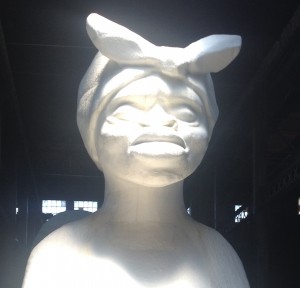On Sunday, we went to the old Domino’s Sugar Factory where Kara Walker, a New York artist, created a five-story sphinx made completely out of sugar. The irony in the sparkling white sphinx matched that of in the entire process of refining sugar: sugar is brown when harvested and must go through a laborious process to be made into white sugar. This process is analogous to the overall commodity fetishism of the sugar industry in the 1800s: black and brown workers are exploited to make products for white consumers.
The most controversial part of the sculpture was the face. Meant to be representative of a slave woman, many decried it as a mammy, a negative stereotype of a desexualized black woman who usually acts as a caregiver of white children, who is sometimes, but not always, a slave. The mammy is usually older, very dark-skinned, has stereotypical “negroid” features” (big nose and lips), overweight, covered hair – basically the exact opposite of female beauty as defined by European standards.
While the artist herself never called the figure a “mammy” so to speak, many people took the sculpture’s big lips and big nose and tied hair to mean so even though this “mammy” was pretty sexualized in both her voluptuous body shape and exposed vulva.
While I agree that the features were purposefully used to represent a woman of African descent, I don’t really agree on the criticism that she’s supposed to be a mammy, this negative representation of what a black woman should be. I understand the history of this controlling image of black womanhood and how’s it’s been used negatively, but I don’t agree that every time a few physical characteristics come together – BAM!- you have a mammy and that’s always negative. Saying that having big lips and a big nose makes one a mammy and that’s always negative is like saying being a single mother makes one a welfare queen and that’s always negative. Attacking a historically “negative” representation by condemning it whenever and however it exists in actuality confirms the negativity associated with that image and further limits what black women are allowed to be and allowed to look like.
I found the sugar sphinx to be quite inspiring. She wasn’t “cute or built to fit a fashion model’s size.” She was representative of a real woman that existed, that was enslaved, exploited, and demeaned. But enshrined as a sphinx in pure white sugar, her face is stoic, regal, almost, as she looks forward in the distance. I am Nigerian and have very West African features. I have dark-skin, big lips, a broad nose, and coarse hair. When I first saw the sculpture, I couldn’t help but compare some of my features to hers. While some would say her face is a caricature, she looks like what some people look like to me. If she is a negative representation of black women, then what does that make me?
When we condemn this figure for even existing, we condemn all black women who resemble it in anyway, strengthening Eurocentric beauty standards and colorism within the black community. Instead, we should reject the controlling image itself. The mammy as an idea shouldn’t exist. A large, dark-skinned older woman should not be considered a mammy – by anyone.
We should question why the only “positive” representation of black women can only be found when black women conform to Eurocentric standards. Dark-skinned, full figured, older women are beautiful, too. We should also ask ourselves why we let superficial phenotypic variances define one’s overall worth and depiction in society.

